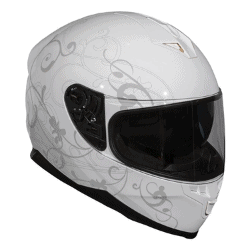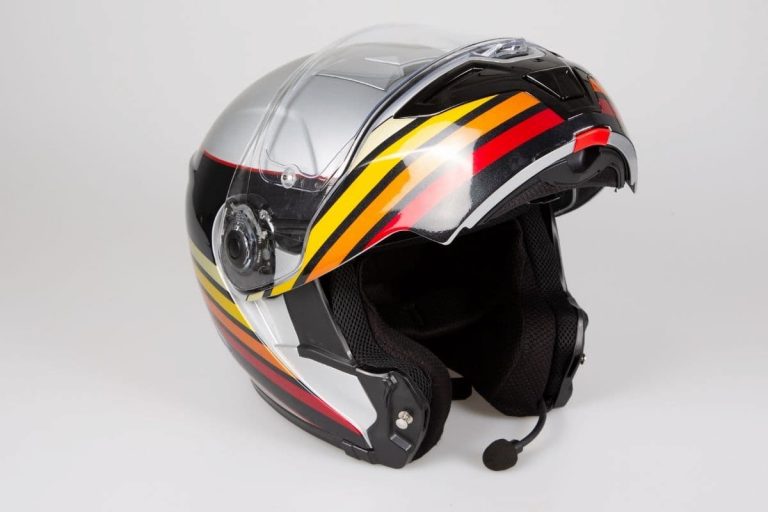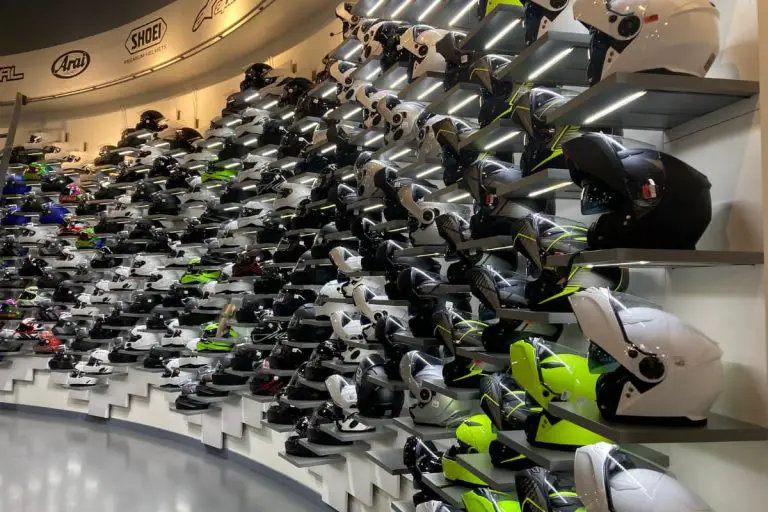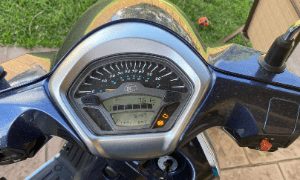Helmets are literally the most important protective gear you’ll need as a rider. It helps to keep the rider safer from harm in the worst case scenarios that are a real concern. Since helmets that provide the most coverage provide the most protection, that leads me to question the moveable function – are modular helmets less safe?
Modular helmets with the appropriate certifications are designated as meeting the minimum safety standards, but technically a full-face helmet offers the best protection as the additional components of a modular add in the potential risk points.
Budget version (DOT & ECE rated still)
What is a Modular Helmet?
There are a few different helmet styles – 1/2 helmets, 3/4, and a full-face helmet.
Modular motorcycle helmets fully cover your head similar to a full-face helmet, but they also have a hinged chin bar that allows a rider to access their entire face when disengaged.
Modular helmets look like full-face helmets, but the difference is that they have a distinct feature that differentiates them from the full-face helmet. This feature is the flip-up visor, and these helmets are sometimes called flip-up helmets. You simply click a button, and it pulls the chin area upwards.
With the ability to move that section, you can grab some water, tell your riding partner something at a stop sign, or just breathe better on a hot day.
You can let it more air, and then you simply flip it back down. It locks into place, and it then seems to be just like a full-face helmet. Except more flexible essentially.
Since it’s designed to move, it definitely lends itself to the question – are modular helmets less safe than a full-face one?
Are Modular Helmets Good?
In general, modular helmets are good as long as they have a DOT certification at a minimum as that indicates the minimum safety testing has been performed and met for this helmet according to the Department of Transportation.
Modular helmets give riders the best of both helmet worlds. Their big advantage over the open-face helmet is that it is safer than the open-face helmet by simply covering more areas of your face and head.
On the other hand, modular helmets provides more comfort than the full-face helmet as a rider does not have to pull off his helmet to do practically anything.
In addition, this important piece of safety gear also has a bunch of features that are offered in many helmet models, as well. Some offer a built-in drop-down sun visor for sun protection, communication systems like the Sena or Cardo, and premium, lightweight materials like carbon fiber.
Click here for the full guide to buying a motorcycle helmet
Are Modular Helmets Less Safe Than a Full-Face Helmet?
When I hear someone ask if a modular motorcycle helmet is safe, I have to start with yes. Mostly. In the United States, a helmet meant for motorcycles must have the Department of Transportation’s (DOT) seal of approval that comes in the form of a sticker on the back of the helmet.
If a helmet has that sticker, it meets the minimum safety requirements for motorcycle riding. Does that mean they are foolproof? No.
There is also a safety designation from the European Union that gives a helmet an ECE sticker similar to the DOT version. They have different safety standards, but even so, there are plenty of modular helmets that have both the DOT and ECE designations.
There is one last well-known-ish certification called the SNELL. They are said to be a gold standard of testing, but as with all designations, it seems that the different style of testing standards still leaves room for debate among the experts. However, the point here is that there is NOT a modular helmet that carries the SNELL stamp of approval at this time.
This ‘missing’ certification makes me think that while modular helmets are as safe as required to be sold for riding, there are some safety standards not met that suggests that modular helmets do not offer the maximum protection compared to a full-face helmet.
While which safety standard is the ‘best’ is open for debate, the fact that not all of them offer the certification for modular helmets makes me question their level of protection.
The full-face helmet is the safest type and provides the best protection to riders simply because of its single-piece construction. There are not indentations along the bottom section which makes it stronger and not as vulnerable at any point.
This means that there is no weak spot on the full-face helmet like those found on the modular helmet.
How Do They Work?
Modular helmets just look exactly like a full-face type of helmet if you do not know what to look for. There is a line that you can see if you look at it more closely that sets them apart is located. That line indicates the spot where the chin area can be flipped up
Modular helmets work by depressing a button along the chin bar that operates on a hinge system to flip upwards.
The hinge system that allows you to easily lift the chin bar with a simple press of a button. This small act of pressing a button transforms the modular helmet from a full-face look alike to an open-face helmet. When flipped back down, the hinged chin bar locks.
The main purpose of this helmet is to make it easier for riders to communicate or a quick stop without having to totally remove your helmet. A rider can also make a quick stop to eat or drink. It’s so much easier than taking the entire helmet off!
Some also have built-in sun visors to help see better on a bright day. The internal sun visor reduces light levels for a safer ride.
Note that riding with the visor of a modular helmet being open is not safe. Eyes should always be covered when riding, and the wind can pull the helmet in unexpected ways. Chin bars can catch wind as they are certainly not designed to help the wind move around your head if they are not latched down. The best and safest way to ride with a modular helmet is with the visor down.
Are Modular Ones SNELL Approved?
Modular helmets sold in the US have to have the Department of Transportation’s (DOT) sticker. That simply means it meets the government’s minimum testing standards. The ECE (European version) also use different testing measures to dictate whether a helmet is safe enough. I have no idea what the right answer is, so I tend to look for helmets with both approvals. That said, there is a 3rd testing standard called the SNELL that is NOT a function of government testing. All 3 have experts looking at this.
Although there are plenty of modular helmets that are DOT and ECE approved, there are no modular helmets with that are SNELL approved.
Not having the SNELL approval makes some riders assume that modular helmets are not safe. However, most modern helmets have ECE 22.05 certification (even modular ones), which some see as equivalent to SNELL’s approval.
Ultimately you have to decide since the types of motorcycle helmets and their testing standards are important to you to ensure you’re riding with the protection of a high-quality helmet.
Are Modular Helmets Heavy?
Modular helmets have a slightly larger weight than full-face helmets because they have inner mechanisms that flip the visor up. The separate components for the hinge and a nice finish that works seamlessly adds a minor amount of weight.
Are Modular Helmets Quieter?
Wind is what makes a helmet noisy, so only allowing in wind for comfort level without blowing out ear drums is important. That said, unlike the open-face helmet, the modular helmet is more efficient in reducing wind noise level, comparatively.
Modular helmets are quieter than those without face coverage. However, the spaces in a modular helmet that allow it to hinge may allow a bit of wind to pass through making the noise higher than a full-face helmet.
However, they are designed to seal the gap well, so I do not notice additional wind coming through.
Are Modular Helmets Worth It?
Surprisingly, modular helmets are not necessarily more expensive than even some open face models. I did some research on what to spend by helmet type, and even the safest motorcycle helmets that are full-face on average cost about what a modular costs.
In general, modular helmets are worth it for riders that want the level of safety a full-face helmet offers with the flexibility to flip the chin bar up for comfort and convenience.
Modular helmets are worth it as they offer riders the needed protection and safety gotten from the full-face helmet and the comfortability and ability to breathe that the open-face helmet brings with it.
To discuss whether the modular helmet is worth it or not, I can’t help but talk about the advantages of modular helmets.
Advantages of Modular Helmets
- Easier communication at stops
- Built-in sun visors
- Improves visor fogging handling
- Hydration easier (nothing like taking your helmet off to grab a quick drink of water)
- Can cool off easier at quick stops if you live in a hot climate
- Full-face protection
- DOT & ECE certified versions available
If the above advantages are important to you, it adds to the case that modular helmets are worth it.
Disadvantages of Modular Helmets
There disadvantages to these helmets, like every other thing. Below are the disadvantages of modular helmets.
- Slightly heavier on average than a full-face helmet
- No model has SNELL certification
- May be less safe as the hinge introduces a weak spot
More detail on the pros and cons of modular helmets






